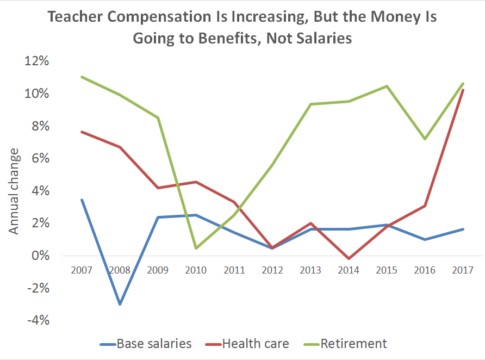
Executive Summary
This report highlights the financial stress facing teachers in regions of fast economic growth and high property values. Teachers in the San Francisco Bay Area report far greater financial anxiety than do samples of adults and workers from across the nation. Public schools in areas of increasing property values and other living costs cannot simply relocate teachers to areas with reasonable property values and short commutes. Teaching differs from the vast majority of other professions because of the need for geographic dispersion. Areas of great economic growth, as well as those of low economic opportunity and low appeal to many college graduates, need teachers for their students. This geographic dispersion of need creates great unevenness in the difficulty of recruiting and retaining teachers. Currently low wages are driving economic anxiety in many parts of country, but in others, even increasing wages are not keeping pace with living costs. The new research shows that these rising costs are creating substantial economic anxiety among teachers and possibly affecting their teaching practice.
The low and declining salaries of teachers has caught public attention. Walkouts in Arizona and West Virginia followed meaningful reductions in teacher salaries of ten percent and nine percent respectively since 2000 in constant dollars. These states are not the only to have seen drops in teachers’ salaries. The spending power of salaries decreased between 2000 and 2017 by 16 percent in Indiana, 15 percent in Colorado, and 12 percent in North Carolina. In 2017, while teacher salaries across the country averaged approximately $59,000, they averaged less than $43,000 in Mississippi and South Dakota. [1]
Average teacher salaries in California and Massachusetts, in contrast, were almost $80,000 in 2017, having increased by over 15 percent since 2000 in constant dollars. Yet, theses higher and increasing salaries mask difficult economic challenges for teachers. Even in these higher paying and increasing salary states, teachers’ economic situation is not necessarily improving and, in fact, can be precipitously declining.
Salaries and property values in some pockets of the US have seen such rapid growth that the salaries for public employees and teachers, while also growing, have not nearly kept pace with the increased costs. Housing prices in San Francisco increased by over 100 percent since 2000. [2] In the city of San Francisco, the median listing price of a home in October of 2017 was approximately $1.2 million and the median monthly rent was $4,450 (Zillow 2017). In the San Francisco Bay Area, more generally, these numbers were only slightly lower at $749,000 and $3,295.
One classic response to higher prices for housing in a particular locale is for workers in that locale to commute in from areas with lower housing prices. In 2016, 15.3 percent of the region’s commuters travelled an average of 60 minutes or more each day, relative to 8.7 percent nationally and up from 12.0 percent three years earlier (U.S. Census Bureau), an indication of a potentially deteriorating quality of life.
Geographical areas experiencing steep economic growth such as San Francisco, New York City, Washington DC need teachers nonetheless than areas that aren’t booming. One of the defining features of the teaching profession is its geographic scope. Teachers are needed everywhere there are students. This pan-geographic need is true for the most remote rural areas as well as the most economically prosperous urban areas.
In a new paper, “Stress in Boom Times: Understanding Teachers’ Economic Anxiety in a High Cost Urban District,” [3] authors Elise Dizon-Ross, Emily Penner, Jane Rochmes and I, build on an economic survey of Americans conducted by Marketplace Edison Research to better understand the economic anxiety of teachers in San Francisco, as a case for better understanding the impact of fast economic growth on professionals in fields in which salaries do not keep pace. We find clear indications of economic stress that affect not only the teachers, but possibly also the students they teach.
Figure 1: Reports of Economic Activity

Teachers in San Francisco report greater economic anxiety than Americans more generally, even comparing them to a sample that includes many workers who did not complete a bachelor’s degree. In Figure 1, the blue line represents San Francisco Unified School District teachers, the orange line represents a national sample of adults, and the grey line represents a national sample of employed adults. We see that while 17 percent of both the full and the employed national sample reported that they were frequently anxious about their current financial situation, a much larger 48 percent of San Francisco teachers reported being frequently anxious. While only three percent of home owners reported finding it “very difficult” to cover monthly housing costs and 12 to 14 percent reported finding it “somewhat difficult” to cover monthly housing costs, for San Francisco teachers these number were a much larger 13 and 35 percent. For renters, the trends are similar. While between four and eight percent of all renters reported finding it “very difficult” to cover monthly housing costs, 27 percent of San Francisco teachers who rent their housing do.
This reported stress comes from substantial differences in teachers’ economic position. As shown in Figure 2, while 67 percent of employed American adults and 63 percent of the full sample report owning a home, only 37 percent of San Francisco teachers own their own home. Meanwhile, San Francisco teachers are far more likely to be paying off student loans, less likely to live with a spouse or partner, more likely to hold a second job to make ends meet, and less likely to report having received or expect to receive an inheritance or other wealth. While stereo-types may characterize teachers as second earners in a two-earner household, this stereo-type is simply inaccurate. Seventy percent of San Francisco teachers report that their income from the school district is majority of their household income.
Figure 2: Teachers Comparative Economic Position

Financial stress is worse for some teachers than for others. Not surprisingly, renters report greater economic stress than do homeowners, those not living with a spouse or partner report greater economic stress than those that do, those paying off student loans report greater economic stress than those who are not. Social connections and family wealth also predict teachers’ economic anxiety. Teachers who report living in poverty during childhood (that is, they report being eligible for subsidized lunch) report greater economic stress, while those that primarily attended San Francisco Bay Area schools as a child report lower economic stress, perhaps due to greater support networks or having family who bought property prior to the dramatic rise in housing costs. Overall, newer, younger teachers and those without close ties to the region face the most difficulties.
The financial anxiety of teachers is rapidly growing economies may have consequences for students. Dizon-Ross et. al. find that teachers who report greater economic stress and those with characteristics that would predict greater economic stress are less positive about teaching, report a greater likelihood of resigning, and, in fact, come to school less. Figure 3 shows the chronic absenteeism rate is nine percentage points higher for teachers who report that covering housing costs is very difficult than for other teachers, and it is 12 percentage point higher for teachers who report being frequently anxious is than it is for less anxious teachers. To the extent that the relationship between financial anxiety and undesirable teacher behavior such as absenteeism is causal – which is consistent with but not established by this pattern of correlations – it raises serious policy issues.
Figure 3: Teaching Perspectives of Teachers with Greater Economic Anxiety Compared to Other Teachers

The need for teachers in every school in every part of the country creates challenges for recruiting teachers to areas with few college graduates. Low wages and difficult working conditions also inhibit schools from hiring and retaining the teachers that their students need. Nonetheless, even in places, like the San Francisco Bay Area – where college graduates abound and teacher salaries are well above those in Kentucky, West Virginia, Arizona and other states where low teacher salaries are front and center in the news and policy discussions – the economic position of teachers has been increasingly difficult. Salaries have not kept up with housing prices and long commutes combine with rising rents to create economic anxiety that affects teachers and may also affect their students. While I don’t have access to a detailed Bay Area analysis, a report from the Learning Policy Institute found that the number of emergency and temporary teaching permits in California tripled, concentrated in difficult-to-staff fields such as special education. [4] A closer look at how to support public employees in economic booms is warranted.
— Susanna Loeb
 Susanna Loeb is the Barnett Family Professor of Education at Stanford University, faculty director of CEPA Labs, and a co-director of Policy Analysis for California Education.
Susanna Loeb is the Barnett Family Professor of Education at Stanford University, faculty director of CEPA Labs, and a co-director of Policy Analysis for California Education.
This post originally appeared as part of Evidence Speaks, a weekly series of reports and notes by a standing panel of researchers under the editorship of Russ Whitehurst.
The author(s) were not paid by any entity outside of Brookings to write this particular article and did not receive financial support from or serve in a leadership position with any entity whose political or financial interests could be affected by this article.
Notes:
1. https://nces.ed.gov/programs/digest/d17/tables/dt17_211.60.asp
2. https://www.paragon-re.com/trend/san-francisco-home-prices-market-trends-news
3. https://cepa.stanford.edu/content/stress-boom-times-understanding-teachers%E2%80%99-economic-anxiety-high-cost-urban-district
4. https://learningpolicyinstitute.org/product/coming-crisis-teaching and follow-up https://learningpolicyinstitute.org/product/ca-district-teacher-shortage-brief





